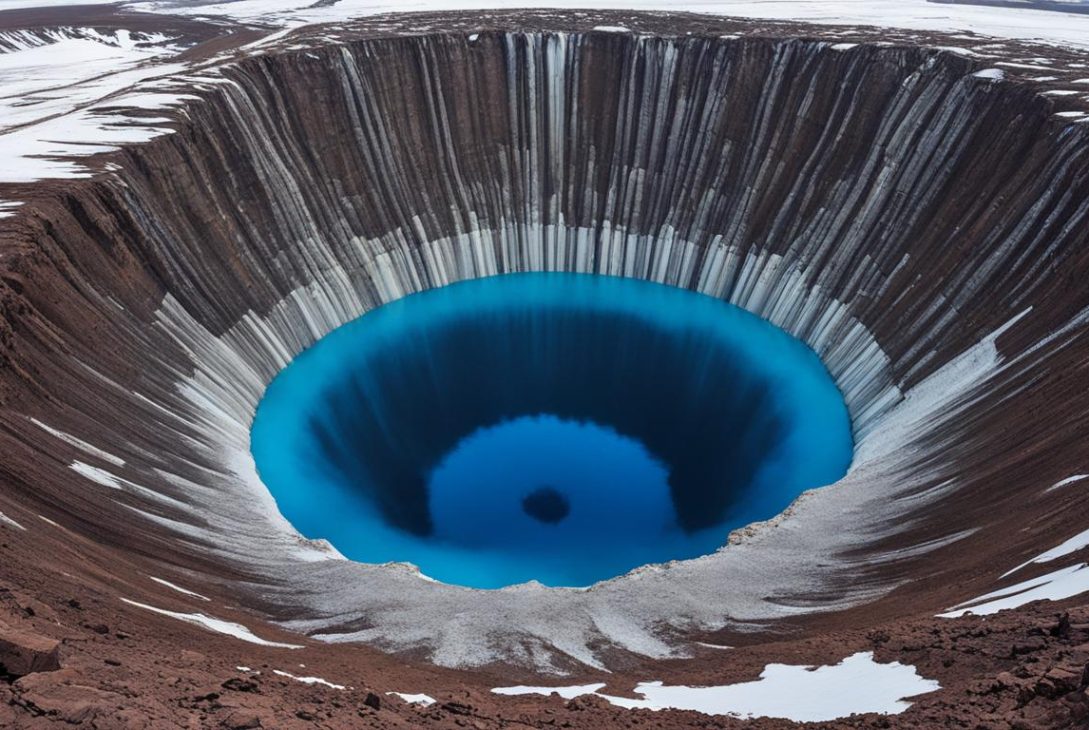The Kola Superdeep Borehole is a remarkable achievement in deep drilling projects and scientific research. Located in the Pechengsky District of Russia’s Murmansk Oblast, it holds the record as the deepest borehole ever drilled for geological study. This project aimed to explore the Earth’s crust and provide valuable insights into its composition and structure.
The drilling of the Kola Superdeep Borehole commenced in 1970 and utilized various drilling rigs to reach a staggering depth of 12,262 meters (40,230 ft) by 1989. This makes it the deepest manmade hole and the borehole with the greatest vertical depth in the world. Throughout its operation, the project encountered numerous drilling challenges, but it persevered and yielded significant scientific discoveries.
Key Takeaways:
- The Kola Superdeep Borehole is the deepest borehole ever drilled for scientific research.
- It was part of a Soviet drilling project aimed at exploring the Earth’s crust.
- The borehole reached a depth of 12,262 meters (40,230 ft), a record in vertical drilling depth.
- The project faced various drilling challenges but provided valuable insights into geological study.
- The Kola Superdeep Borehole continues to inspire further advancements in deep drilling projects and geological research.
The History of the Kola Superdeep Borehole
The Kola Superdeep Borehole project, initiated by the Soviet Union in 1970, aimed to drill deep into the Earth’s crust to gain insights into its structure. The project employed the Uralmash-4E drilling rig initially and later switched to the Uralmash-15000 series. This ambitious endeavor set records as the deepest manmade hole and the longest borehole in terms of measured depth.
The project faced financial challenges throughout its duration and was eventually closed in 1995. However, its significance in the realm of scientific research and exploration of the Earth’s crust cannot be understated. The Kola Superdeep Borehole project paved the way for deep drilling projects worldwide and contributed valuable knowledge to the field.
Technical Specifications
| Drilling Rig | Start Year | Depth Reached |
|---|---|---|
| Uralmash-4E | 1970 | 7,000 meters (23,000 ft) |
| Uralmash-15000 series | 1979 | 12,262 meters (40,230 ft) |
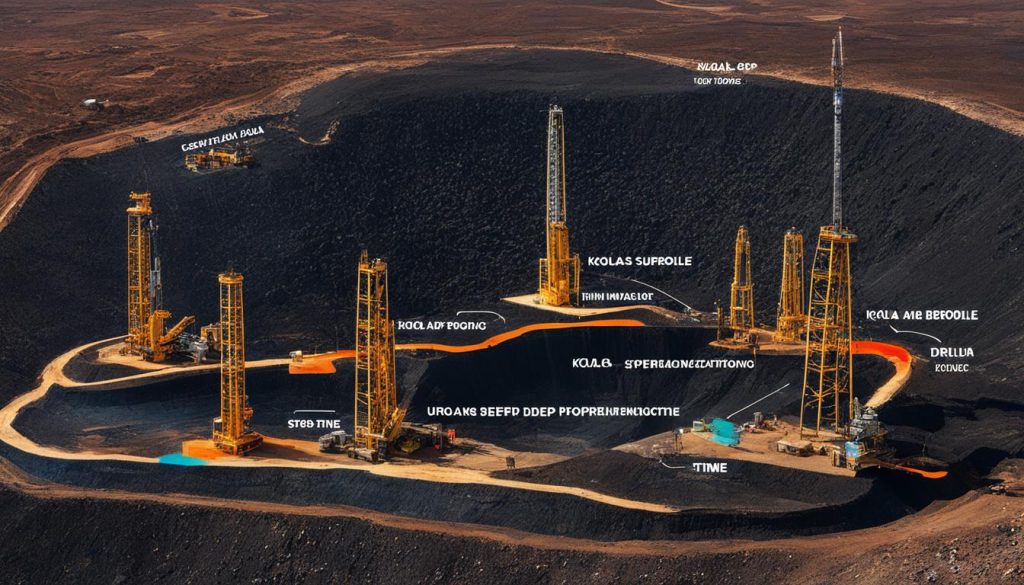
“The Kola Superdeep Borehole project demonstrated the capabilities and challenges of drilling to extreme depths, leaving a profound impact on the scientific community.” – Dr. Elena Petrova, Geological Research Scientist
The project’s drilling depth record remains unmatched, providing researchers with unique geological samples and valuable data. Despite its closure, the Kola Superdeep Borehole project continues to inspire and serve as a cornerstone for future scientific endeavors, furthering our understanding of the Earth’s crust and its intricate mysteries.
Challenges and Achievements of the Kola Superdeep Borehole
The Kola Superdeep Borehole encountered numerous challenges during its drilling process, pushing the boundaries of scientific exploration. The project aimed to reach unprecedented depths in the Earth’s crust, requiring the drilling rig to withstand extreme temperatures and pressures as it delved deeper into the Earth.
In 1984, a significant setback occurred when a section of the drill string twisted off and became lodged in the hole, causing a delay in drilling operations. Despite this setback, the Kola Superdeep Borehole project achieved remarkable milestones, including reaching a depth of 12,262 meters (40,230 ft).
“The project faced numerous challenges but provided valuable scientific data and insights into the geology of the Earth’s crust.”
This exceptional drilling depth record at the Kola Superdeep Borehole remains unmatched, making it the deepest borehole ever drilled and the world record for the deepest artificial point on Earth. The colossal drilling achievement not only pushed the boundaries of scientific knowledge but also demonstrated the resilience and ingenuity of the researchers and engineers involved.
This groundbreaking project yielded a wealth of valuable scientific data and insights into the geology of the Earth’s crust. The geological samples obtained from various depths provided researchers with unprecedented access to the Earth’s layers, enabling a more comprehensive understanding of its composition and structure.
The achievements of the Kola Superdeep Borehole project continue to inspire further advancements in deep drilling technology and scientific exploration. The challenges faced and overcome during the project paved the way for future scientific endeavors, fostering a deeper understanding of our planet’s geological history and contributing to ongoing research in the field of geology.
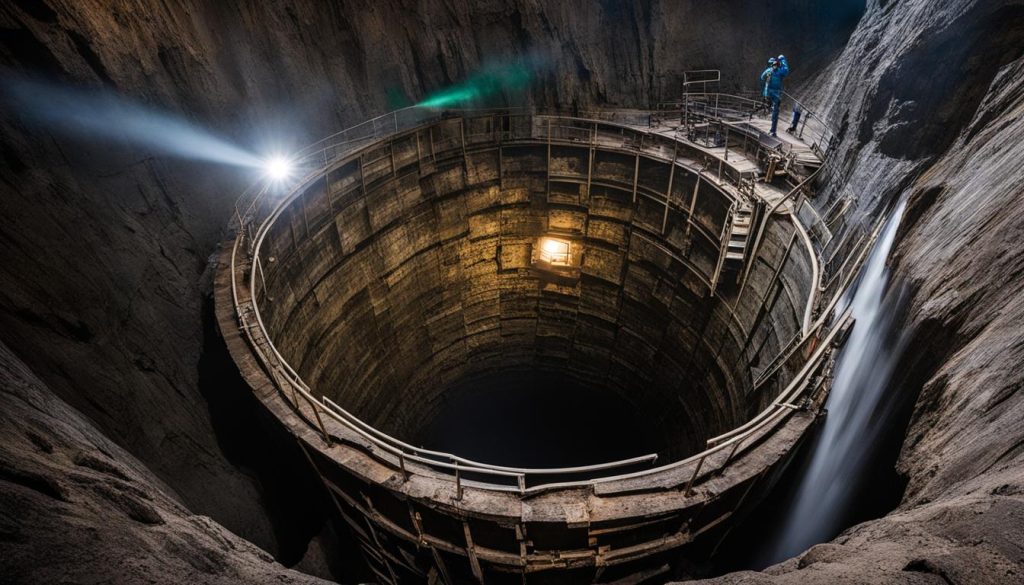
As we delve deeper into the mysteries of the Earth, the Kola Superdeep Borehole serves as a testament to the daring pursuit of scientific knowledge and the boundless limits of human curiosity.
Scientific Discoveries from the Kola Superdeep Borehole
The exploration of the Earth’s crust through deep drilling projects has been instrumental in uncovering various scientific discoveries. The Kola Superdeep Borehole has played a significant role in advancing our understanding of the Earth’s geological processes and formations.
One of the most notable scientific discoveries from the Kola Superdeep Borehole was the revelation of unexpected geological formations. The absence of basaltic layers and the presence of granites at greater depths challenged existing geological models. This discovery prompted scientists to reevaluate their understanding of the Earth’s crust composition and structure.
Furthermore, the borehole provided crucial insights into the presence of water at great depths. The discovery suggested the existence of aquifers beyond previous scientific predictions, expanding our understanding of the Earth’s water systems and potentially contributing to future research into sustainable water resources.
The scientific data collected from the Kola Superdeep Borehole continues to contribute to ongoing research on the Earth’s crust. Researchers analyze the data to investigate geological processes, seismic activity, and the interaction between different layers of the Earth’s crust. The depth and precision of the borehole’s measurements have provided invaluable information for further geological studies and exploration.
Notable Scientific Discoveries:
- The absence of basaltic layers
- The presence of granites at greater depths
- Confirmation of water presence at great depths
The scientific discoveries from the Kola Superdeep Borehole have significantly contributed to our understanding of the Earth’s crust, reshaping geological models and theories. These findings highlight the importance of scientific exploration and deep drilling projects in expanding our knowledge of our planet.
Location and Coordinates of the Kola Superdeep Borehole
The Kola Superdeep Borehole is situated in the picturesque Pechengsky District of Murmansk Oblast, Russia. Its highly accurate coordinates are 69°23′47″N 30°36′36″E. Positioned on the stunning Kola Peninsula, near the border with Norway, the borehole blends in harmoniously with the natural beauty of the region. It has become a fascinating destination for visitors intrigued by geological research and the captivating history of deep drilling projects.
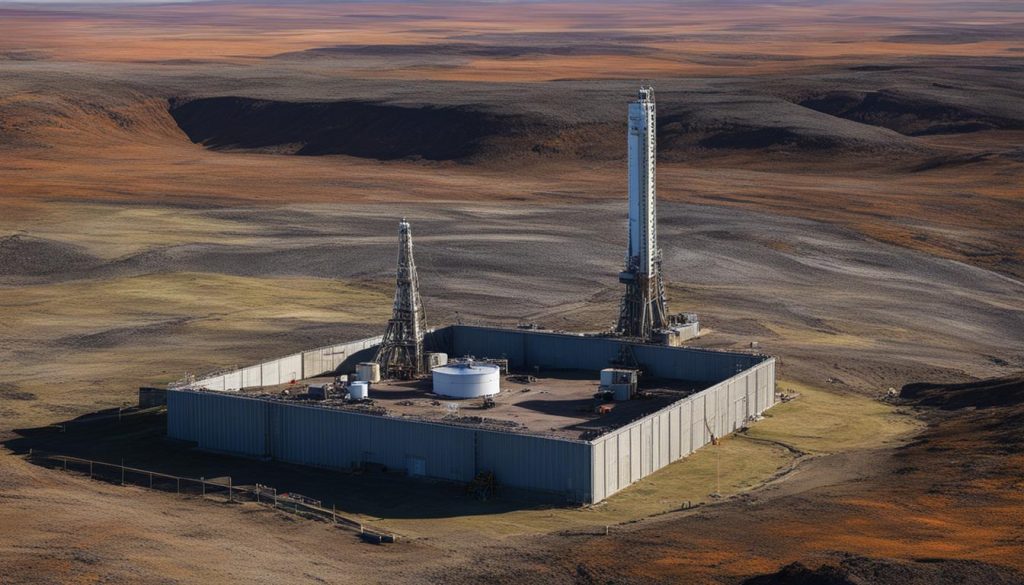
Explore the Kola Superdeep Borehole’s enigmatic location on the interactive map below:
| Point of Interest | Distance |
|---|---|
| Kola Superdeep Borehole | 0 km |
| Murmansk | 150 km |
| Norwegian Border | 15 km |
| Khibiny Mountains | 30 km |
Plan your visit to the Kola Superdeep Borehole and immerse yourself in the wonders of geological exploration.
Technological Advancements in Drilling Technology
The Kola Superdeep Borehole project was not only a remarkable scientific endeavor but also a testbed for pushing the boundaries of drilling technology. In order to reach the desired depths, the drilling rigs used for the project had to be modified and equipped with advanced capabilities. These technological advancements were crucial to overcome the challenges posed by drilling at extreme depths and to ensure the safety and efficiency of the operation.
The drilling rigs used in the Kola Superdeep Borehole project were specifically designed to handle the high temperatures and pressures encountered as they penetrated deeper into the Earth’s crust. Modifications were made to the rigs’ materials, cooling systems, and drilling mechanisms to withstand these harsh conditions. The Russian drilling project, Kola Superdeep Borehole, served as a catalyst for the development of improved drilling technologies capable of drilling to great depths in various geological formations for both scientific and industrial purposes.
Drilling techniques and equipment underwent significant advancements throughout the project. The project’s engineers and scientists gained valuable insights into what it takes to drill into rock formations thousands of meters below the surface. This knowledge paved the way for improved drilling strategies, such as the utilization of diamond-tipped drill bits and enhanced drilling fluids, which increased drilling efficiency and reduced wear and tear on the drilling equipment. Additionally, the project contributed to the advancement of borehole stability and cementing techniques, ensuring the integrity of the borehole during and after drilling operations.
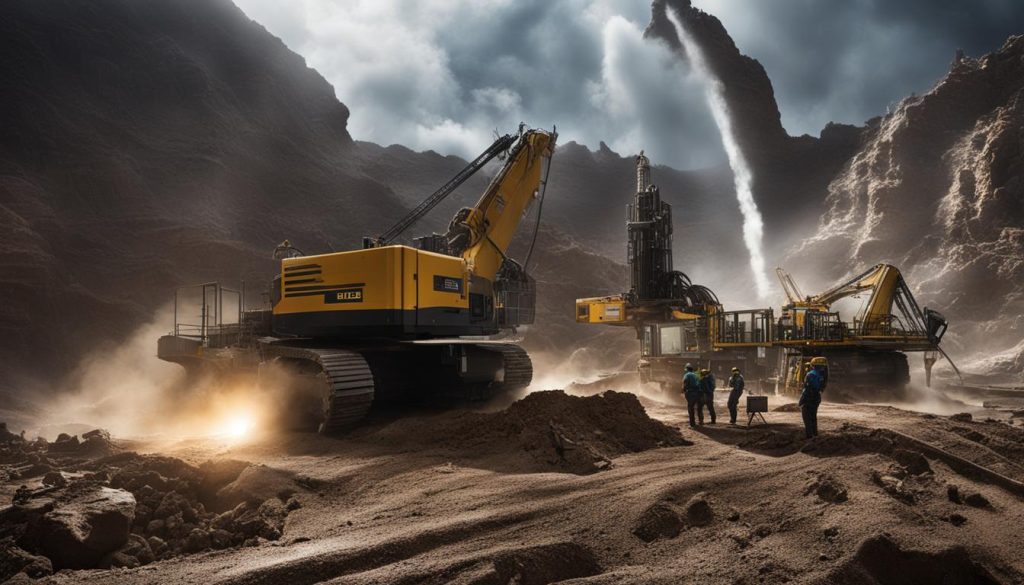
Furthermore, the data and experiences gathered from the Kola Superdeep Borehole project have significantly influenced subsequent scientific drilling projects worldwide. The knowledge gained from this endeavor has been instrumental in the development and refinement of drilling technology for various applications, including geological research, mineral exploration, and oil and gas extraction. The technological advancements made as part of the Kola Superdeep Borehole project have had a lasting impact on the drilling industry, driving innovation and improving our understanding of the Earth’s subsurface.
Overall, the Kola Superdeep Borehole project served as a catalyst for the advancement of drilling technology. The project’s innovative approaches and technological developments have revolutionized the way we approach drilling operations in challenging environments. The legacy of the Kola Superdeep Borehole continues to influence scientific and industrial drilling projects, ensuring that we continue to push the boundaries of exploration and gain deeper insights into the Earth’s geological makeup.
Implications for Geological Study and Understanding Earth’s Crust
The Kola Superdeep Borehole project has had far-reaching implications for the geological study and our understanding of the Earth’s crust. By delving deep into the Earth’s surface, scientists have gained valuable insights into the composition, structure, and movements of the planet’s crust, contributing to the advancement of geological research.
The data collected from the borehole has provided scientists with a wealth of information, helping them better comprehend the complex nature of the Earth’s crust. Through the analysis of rock samples, researchers have been able to identify various layers and formations, shedding light on the geological history of our planet.
The exploration of the Earth’s crust through projects like the Kola Superdeep Borehole has allowed scientists to refine existing geological models and theories. By studying the properties of different rocks and their distribution at varying depths, researchers have developed a more comprehensive understanding of the geological processes that have shaped and continue to shape the Earth.
The findings from the Kola Superdeep Borehole have also facilitated advancements in our understanding of tectonic plate movements and associated phenomena such as earthquakes and volcanic activity. The data gathered from the borehole has provided valuable evidence of plate boundaries and the mechanisms behind plate tectonics, contributing to the field of seismology and geophysics.
“The study of the Kola Superdeep Borehole has opened up new avenues for geological research, deepening our understanding of Earth’s crust and the processes that shape our planet.”
| Implications for Geological Study and Understanding Earth’s Crust |
|---|
| The Kola Superdeep Borehole project has provided valuable insights into the composition, structure, and movements of the Earth’s crust. |
| The data collected from the borehole has contributed to the refinement of geological models and theories. |
| The exploration of the Earth’s crust through the borehole has deepened our understanding of tectonic plate movements. |
| The findings from the borehole have advanced the fields of seismology and geophysics. |
Legacy and Future of Deep Drilling Projects
The Kola Superdeep Borehole project conducted by the Soviet Union has left an enduring legacy in the realm of deep drilling and scientific research. Through this groundbreaking endeavor, the project had not only showcased the possibilities of drilling to unprecedented depths but also shed light on the unique challenges associated with such ambitious undertakings. It paved the way for future exploration and geological studies of the Earth’s crust, catalyzing scientific curiosity and fostering advancements in the field.
Deep drilling projects worldwide continue to draw valuable insights and build upon the knowledge gained from the Kola Superdeep Borehole. The project acted as a catalyst for advancements in geological research, ultimately expanding our understanding of the Earth and its intricate geological processes.
As the world embarks on future deep drilling projects, the scientific community recognizes the significance of the Kola Superdeep Borehole’s contributions. The project’s success and challenges have influenced subsequent drilling technologies and methodologies, further enhancing our ability to explore and study the Earth’s crust with greater precision and accuracy.
Geological study and deep drilling projects serve as crucial avenues for investigating the mysteries of the Earth’s crust and unlocking its geological secrets. These endeavors allow scientists to gain profound insights into the planet’s formation, history, and dynamic processes.
The Kola Superdeep Borehole remains an emblematic example of the capabilities and adventuresome spirit of human scientific curiosity. Although the project was eventually discontinued, its impact and legacy continue to shape the trajectory of deep drilling projects and our understanding of the Earth’s intricate geological systems. As humanity endeavors to unravel the secrets of our planet, the legacy of the Kola Superdeep Borehole serves as an enduring source of inspiration and encouragement.
Conclusion
The Kola Superdeep Borehole stands as a testament to the pursuit of scientific knowledge and the spirit of exploration. With its awe-inspiring depth and groundbreaking achievements in drilling, it has significantly advanced our understanding of the Earth’s crust and geological processes. Despite facing numerous challenges along the way, the project yielded invaluable scientific data and insights into geological formations.
As the deepest borehole ever drilled, the Kola Superdeep Borehole holds a special place in the history of scientific research. It has provided scientists with a wealth of information about the Earth’s crust and has contributed to the development of geological models and theories. The project’s legacy continues to shape the field of deep drilling, inspiring further scientific endeavors and advancements.
Although the borehole is no longer in operation, its impact on the scientific community is undeniable. The knowledge and experiences gained from the Kola Superdeep Borehole have paved the way for future exploration and research. This remarkable feat of engineering and scientific inquiry serves as a testament to human curiosity and the endless quest for knowledge about our planet.
FAQ
What is the Kola Superdeep Borehole?
The Kola Superdeep Borehole is the deepest borehole ever drilled for scientific research. It was part of a Soviet drilling project that aimed to explore the Earth’s crust. The drilling began in 1970 and reached a depth of 12,262 meters (40,230 ft) in 1989, setting a record for the deepest manmade hole and the deepest borehole in terms of vertical depth.
When did the drilling of the Kola Superdeep Borehole begin and end?
The drilling of the Kola Superdeep Borehole began in 1970 and ended in 1995. However, the project achieved significant milestones, including reaching a depth of 12,262 meters (40,230 ft) in 1989.
What were the main challenges faced during the drilling of the Kola Superdeep Borehole?
The drilling of the Kola Superdeep Borehole faced challenges such as high temperatures and pressures as it went deeper into the Earth’s crust. In 1984, a section of the drill string twisted off and was left in the hole, causing a delay in drilling. Despite these challenges, the project achieved significant milestones, including setting the record for the deepest artificial point on Earth.
What scientific discoveries were made through the Kola Superdeep Borehole?
The Kola Superdeep Borehole yielded important scientific discoveries, such as unexpected geological formations and the presence of water at great depths. These findings challenged existing geological models and contributed to a better understanding of the Earth’s crust.
Where is the Kola Superdeep Borehole located?
The Kola Superdeep Borehole is located in the Pechengsky District of Russia’s Murmansk Oblast. Its exact coordinates are 69°23′47″N 30°36′36″E. The borehole is situated on the Kola Peninsula, near the Russian border with Norway.
How did the Kola Superdeep Borehole contribute to technological advancements in drilling?
The Kola Superdeep Borehole pushed the boundaries of drilling technology at the time. The project required advancements in drilling techniques and equipment to reach the desired depths. The technological advancements made during the project have since contributed to developments in drilling technology and subsequent scientific drilling projects.
What are the implications of the Kola Superdeep Borehole for geological study and understanding Earth’s crust?
The data collected from the Kola Superdeep Borehole has helped scientists better understand the structure, composition, and movement of the Earth’s crust. It has also contributed to the development of geological models and theories, expanding our knowledge of the Earth’s geological history.
What is the legacy of the Kola Superdeep Borehole and the future of deep drilling projects?
The Kola Superdeep Borehole left a lasting legacy in the field of deep drilling and scientific research. It demonstrated the capabilities and challenges of drilling to great depths and opened up new possibilities for geological study. Deep drilling projects around the world build upon the knowledge and experiences gained from the Kola Superdeep Borehole, fueling advancements in geological research and expanding our understanding of the Earth.
Source Links
- https://en.wikipedia.org/wiki/Kola_Superdeep_Borehole
- https://medium.com/@darkenergyarticles/an-extraordinary-story-a-hole-to-hell-itself-kola-superdeep-borehole-211b7091e2e8
- https://science.howstuffworks.com/engineering/civil/kola-superdeep-borehole.htm
it holds the record as the deepest borehole ever drilled for geological study. this project aimed to explore the earth's crust and provide valuable insights int kola superdeep borehole: the whole story unveiled The Hole To Hell the kola superdeep borehole is a remarkable achievement in deep drilling projects and scientific research. located in the pechengsky district of russia's murman
Last modified: January 17, 2024


